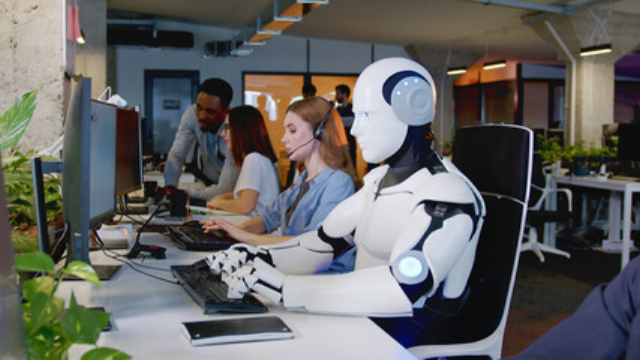Are you curious about the future of work and the impact of AI? Well, get ready because artificial intelligence is poised to revolutionize various industries, replacing certain jobs along the way. In this article, we will explore the jobs that AI is likely to replace, including customer service roles, transportation and delivery jobs, data analysis and research positions, manufacturing and assembly work, and administrative and clerical tasks. So buckle up and prepare for a glimpse into the future of employment.
Customer Service Roles
AI will replace customer service roles. With the rapid advancements in artificial intelligence (AI) technology, virtual assistants and chatbots are becoming increasingly sophisticated in their ability to handle customer inquiries and provide support. These AI-powered systems are capable of understanding natural language, interpreting customer requests, and offering personalized responses, making them well-suited for customer service tasks.
Virtual assistants, such as Amazon’s Alexa or Apple’s Siri, are already transforming the way customers interact with businesses. These voice-activated AI assistants can provide information, answer questions, and even perform certain tasks on behalf of the user. As their capabilities continue to improve, virtual assistants will be able to handle more complex customer service interactions, reducing the need for human intervention.
Chatbots, on the other hand, are computer programs designed to simulate human conversation. They can be integrated into websites, messaging apps, or social media platforms to provide instant responses to customer inquiries. Chatbots use AI algorithms to analyze customer queries, retrieve relevant information, and generate appropriate responses. As AI technology advances, chatbots will become more intelligent and better equipped to handle a wide range of customer service scenarios.
While AI will undoubtedly replace certain customer service roles, it is important to note that human interaction still holds value in certain situations. Complex or emotionally charged issues may require the empathy and understanding that only a human customer service representative can provide. Nonetheless, AI-powered virtual assistants and chatbots will continue to play an increasingly prominent role in the customer service landscape, enhancing efficiency and improving customer experiences.
Transportation and Delivery Jobs
Prepare for the disruption of transportation and delivery jobs as AI technology takes over essential tasks. Driverless vehicles and automated warehouses are revolutionizing the way goods are transported and delivered, eliminating the need for human drivers and manual labor.
| Pros of AI in Transportation and Delivery Jobs | Cons of AI in Transportation and Delivery Jobs |
|---|---|
| Increased efficiency and productivity | Job displacement and unemployment |
| Reduced human error and accidents | Potential security and privacy concerns |
| Lower costs and faster delivery | Technological and infrastructure challenges |
Driverless vehicles, equipped with advanced sensors and algorithms, can navigate roads and transport goods without human intervention. They can operate 24/7, delivering goods faster and more efficiently, while also reducing the risk of accidents caused by human error. Additionally, automated warehouses utilize AI-powered robots to handle tasks such as sorting, packing, and loading, resulting in increased productivity and reduced labor costs.
However, the widespread adoption of AI in transportation and delivery jobs raises concerns about job displacement and unemployment. As AI technology takes over these tasks, many drivers and warehouse workers may find themselves without employment. Furthermore, there are potential security and privacy concerns associated with the use of AI in transportation and delivery, as it involves the collection and processing of vast amounts of data.
Despite these challenges, the integration of AI in transportation and delivery jobs offers numerous benefits, including increased efficiency, reduced costs, and improved safety. As AI continues to advance, it will be crucial for policymakers, businesses, and workers to adapt and find new roles in this evolving landscape.
Data Analysis and Research Positions
You regularly rely on data analysis and research positions, but AI will soon be replacing them. With advancements in technology, AI has the potential to automate data analysis processes, significantly impacting the way research is conducted. Data analysis automation refers to the use of AI algorithms to analyze large datasets, extract relevant information, and generate insights. This automation can eliminate the need for human analysts, as AI systems can process data faster and more accurately.
The impact of AI on research methodologies is profound. Traditionally, researchers spend a significant amount of time collecting and analyzing data manually. However, with the introduction of AI, this process can be expedited. AI algorithms can sift through vast amounts of data, identifying patterns and correlations that may not be immediately apparent to human researchers. This not only saves time but also increases the accuracy of research findings.
Furthermore, AI can also enhance the quality of research by reducing human bias. Human researchers are susceptible to cognitive biases, which can influence their interpretation of data. AI, on the other hand, can analyze data objectively, eliminating bias and providing unbiased insights.
While AI will replace certain aspects of data analysis and research positions, it is important to note that human involvement will still be necessary. AI can provide valuable insights and automate certain tasks but cannot completely replace the critical thinking and creativity that human researchers bring to the table. As AI continues to advance, it is crucial for data analysts and researchers to embrace this technology and find ways to work alongside AI systems to enhance their capabilities.
Manufacturing and Assembly Work
As technology continues to advance, the impact of AI on jobs extends beyond data analysis and research positions to include manufacturing and assembly work. Automated production and robotic assembly are revolutionizing these industries, increasing efficiency and productivity while reducing costs.
One of the key advantages of AI in manufacturing and assembly is its ability to perform repetitive tasks with precision and speed. This eliminates the need for human workers to engage in monotonous and physically demanding jobs, freeing them up for more complex and creative tasks. AI-powered robots can assemble products with incredible accuracy, ensuring consistent quality and reducing the risk of errors.
To give you an idea of the capabilities of AI in manufacturing and assembly work, let’s take a look at the table below:
| Task | Human Worker | AI-Powered Robot |
|---|---|---|
| Assembly | Requires training and physical effort | Can perform intricate assembly tasks effortlessly |
| Quality Control | Subjective judgment | Can detect defects with high accuracy |
| Inventory Management | Time-consuming and prone to errors | Can track and manage inventory in real-time |
| Packaging and Shipping | Manual labor and potential for errors | Can handle packaging and shipping autonomously |
As you can see, AI is transforming manufacturing and assembly work by automating processes and improving efficiency. While this may lead to some job displacement, it also creates new opportunities for workers to upskill and focus on tasks that require human ingenuity and problem-solving abilities.
Administrative and Clerical Tasks
Moving on to administrative and clerical tasks, AI is also making significant advancements in this area, revolutionizing the way these tasks are performed and enhancing efficiency in various office settings. Here are five ways AI is transforming administrative and clerical tasks:
- Communication automation: AI-powered chatbots and virtual assistants are streamlining communication processes by automatically responding to emails, scheduling meetings, and answering common queries. This reduces the burden on administrative staff and allows them to focus on more complex tasks.
- Document management: AI algorithms are being used to organize and categorize documents, making it easier to search for specific information and ensuring that important files are not lost or misplaced. This improves productivity and saves time spent on manual document management.
- Data entry and processing: AI technologies are capable of extracting and analyzing data from various sources, eliminating the need for manual data entry and significantly reducing the chances of human errors. This increases accuracy and efficiency in administrative tasks.
- Workflow optimization: AI systems can analyze patterns in administrative workflows to identify bottlenecks and suggest improvements. By automating repetitive tasks and assigning work more efficiently, AI optimizes the workflow and enhances overall productivity.
- Virtual meeting assistants: AI-powered tools can assist in virtual meetings by transcribing conversations, providing real-time language translation, and even summarizing meeting minutes. This ensures effective communication and collaboration, particularly in global and remote teams.



